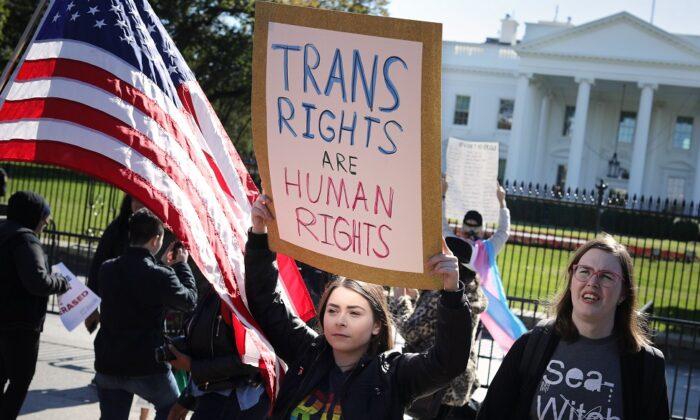Do you remember when you first heard of the terms “nonbinary” or “gender fluid”? How about “gender-expansive” or “gender-nonconforming”? I bet it was within the past five years.
It states: “The expression of transgender identity, or any other form of gender-expansive behavior, is a healthy, appropriate and typical aspect of human development. A gender-expansive student should never be asked, encouraged or required to affirm a gender identity or to express their gender in a manner that is not consistent with their self-identification or expression. Any such attempts or requests are unethical and will likely cause significant emotional harm.”
It continues: “Ongoing learning is a key element of this process. Educators and administrators need to engage in regular professional development and training to build a school climate that avoids gender stereotyping and affirms the gender of all children.”
The guide also states that teaching children gender ideas will help them to “explore a greater range of interests, ideas, and activities.”
Gone are the comparatively simple days of just having a couple of “trans students” at school—when we had maybe one or two students in the whole school who identified as the opposite gender of their biological sex. We are now living in a time where kids are encouraged to be “gender-expansive”—a broader, more flexible range of gender identities or expressions than those typically associated with the “binary gender system.”
Confused yet? You should be.
When I see this, I think of the first 10 years of my teaching career when this wasn’t even a consideration, because we didn’t have any students who identified as nonbinary. I feel sorry for Gen Z. Many of these students, if they were just born 10 years before, wouldn’t even be questioning their gender. Maybe we weren’t repressing them back then; we just weren’t giving them the idea.
Now, our nation’s children are bombarded with trending TikTok videos of teens changing their preferred pronouns monthly and images of young women showing off their scarred chests from double mastectomies. The pressure of culture alone is often overpowering for young people, but on top of that, many of the adults in their lives—their teachers—affirm this toxic behavior as normal.
Back to the “Schools in Transition” guide. It claims that teachers are unethical if we don’t affirm these various identities, that we will emotionally harm the students. You read that right; the teachers who don’t push and affirm this confusing array of new genders, as varied as the stripes on the ever-expanding gender rainbow flag, we are labeled as emotionally harming our students!
It gets worse. The guide also addresses what a teacher or administrator should do if a parent is unsupportive of their child changing their gender identity at school. The guide emphasizes the importance of asking the child if their family knows about their change in identity. If they don’t, the guide suggests that teachers and administrators be careful not to “out” the student to their parents.
Think this is all just recommendations from some obscure guide? Think again. In my former district in Salinas, California, a teacher called home using the new name and pronoun of a student who had changed their gender identity at school. The parent had no idea who they were talking about because they were completely unaware of the secret identity change done at school.
After this incident, teachers were instructed not to use a student’s new name and pronouns unless it was clear that the parent was aware of the gender identity change. In other words, hide the identity change from the parent.
This hiding of new pronouns and names being changed is standard policy in many states nationwide and is also recommended in the guide. Encouraging children to keep secrets from their parents is also one of the telltale signs of “grooming,” but I digress.
As a former public school teacher of 15 years in California, I only recently started seeing more students identifying as trans or nonbinary. When I began my teaching career 15 years ago, none of my students identified as nonbinary. None. Teachers weren’t asking students to share their pronouns at the beginning of the school year. My colleagues weren’t putting their preferred pronouns at the end of emails. We didn’t have to worry about mis-pronouning a student. (Is “mis-pronouning” even a word? It’s all so confusing.) I think back to that time and it seems like a dream.
We are asked to refer to an individual “nonbinary” student as they/them. I’m an English teacher! For the majority of my career, I taught English language learners (ELLs). Are we going to throw out a basic English language rule and refer to a single student in plural form? Oh, you better, if you want to keep your job and maybe avoid a lawsuit. And forget about confusing the ELLs; that’s collateral damage.
Not only are we pressured by our woke administrators and colleagues to use these grammatically incorrect pronouns with our students, but we’re also being told not to address our class in “gendered” language. So “ladies and gentlemen” or “boys and girls” isn’t progressive or inclusive and shouldn’t be used. We are given posters with “inclusive” greetings we can use instead, such as “scholars” or “friends.” Remember the posters about determination and perseverance that were hung up at schools when you were a kid? The kind with pictures of athletes and maybe a cat hanging on to a string for dear life. Well, posters in schools are different now.
When I taught middle school, I had my students line up with their gender, a line of boys and a line of girls. Organizing students by two genders wasn’t a problem for many years. In fact, it was pretty normal to separate students by gender in our schools until the past five years. Now, this simple act of having students form two lines outside of class is something teachers have to question, lest the thought police come after them for the crime of wrongthink and emotionally harming the nonconforming students.
Not only is there an ever-expanding “gender spectrum,” but the American public is expected to keep up with the latest gender-inclusive terms and to change their speech patterns to accommodate it. If we don’t comply, we risk being labeled bigots, hateful, and intolerant. This label can include further consequences for teachers like myself, including losing our jobs.
Again, I want to say that none of this was an issue we faced as teachers 10 years ago.
I’m worried about our future. I’m worried about teachers having to go against their conscience to keep their jobs. But mostly, I’m worried about our children, confused by activists posing as teachers and the unknown psychological and physical damage they are inflicting on the next generation.
So what do we do? In the chaos of gender confusion, one thing is clear: No one solution is going to fix this. It’s all hands on deck, and we must work against this madness in every way possible.
Consider running for the school board. Go to your school board meetings. And don’t assume that because you’re in a red state that “they don’t do that stuff around here”—don’t be naive. When those classroom doors close, that’s when the activists have the opportunity to indoctrinate. Teach your children how to spot when a teacher is trying to push radical gender theory on them and to tell you if they do try it.
Better yet, pull your kids out of public school if you can. Many states have passed new laws providing school choice vouchers that can help pay for private schools. That’s why my husband and I started our own private K–12 online school to combat these “woke” ideologies.
Legislative protection is one of the best ways to fight back. The Parents Rights in Education Act proposed and passed by Florida Gov. Ron DeSantis is a good start. In the famously and falsely labeled Florida “Don’t Say Gay” bill, parents are protected from having their child’s gender unknowingly changed at school. It also bans gender and sexual orientation conversations for K–3 students in the classroom, giving the teachers in Florida some room to breathe.
Laws should be passed like this nationwide. It’s not enough to elect conservatives opposed to this Brave New Gender-Fluid World; you must pressure them to pass laws like the Parents Rights in Education Act in your home state. Let your voice be heard.
In short, use whatever time and skills you have to defend our nation’s children. Imagine the irreversible damage that could be done to our children if we don’t.


